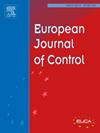On controllability of temporal networks
IF 2.5
3区 计算机科学
Q2 AUTOMATION & CONTROL SYSTEMS
引用次数: 0
Abstract
Temporality has been recently identified as a useful feature to exploit when controlling a complex network. Empirical evidence has in fact shown that, with respect to their static counterparts, temporal networks (i) are often endowed with larger reachable sets and (ii) require less control energy when steered towards an arbitrary target state. However, to date, we lack conditions guaranteeing that the dimension of the controllable subspace of a temporal network is larger than that of its static counterpart. In this work, we consider the case in which a static network is input connected but not controllable. We show that when the structure of the graph underlying the temporal network remains the same throughout each temporal snapshot while the (nonvanishing) edge weights vary, then the temporal network will be completely controllable almost always, even when its static counterpart is not. An upper bound on the number of snapshots needed to achieve controllability is also provided.
论时空网络的可控性
最近,人们发现时间性是控制复杂网络时可以利用的一个有用特征。经验证据表明,与静态网络相比,时态网络(i) 通常具有更大的可到达集,(ii) 在导向任意目标状态时所需的控制能量更少。然而,迄今为止,我们还缺乏保证时态网络可控子空间维度大于静态网络可控子空间维度的条件。在这项研究中,我们考虑了静态网络具有输入连接但不可控的情况。我们的研究表明,当时态网络底层图的结构在每个时态快照中保持不变,而(非消失)边的权重发生变化时,时态网络几乎总是完全可控的,即使其静态对应网络并不可控。此外,还提供了实现可控性所需的快照数量上限。
本文章由计算机程序翻译,如有差异,请以英文原文为准。
求助全文
约1分钟内获得全文
求助全文
来源期刊

European Journal of Control
工程技术-自动化与控制系统
CiteScore
5.80
自引率
5.90%
发文量
131
审稿时长
1 months
期刊介绍:
The European Control Association (EUCA) has among its objectives to promote the development of the discipline. Apart from the European Control Conferences, the European Journal of Control is the Association''s main channel for the dissemination of important contributions in the field.
The aim of the Journal is to publish high quality papers on the theory and practice of control and systems engineering.
The scope of the Journal will be wide and cover all aspects of the discipline including methodologies, techniques and applications.
Research in control and systems engineering is necessary to develop new concepts and tools which enhance our understanding and improve our ability to design and implement high performance control systems. Submitted papers should stress the practical motivations and relevance of their results.
The design and implementation of a successful control system requires the use of a range of techniques:
Modelling
Robustness Analysis
Identification
Optimization
Control Law Design
Numerical analysis
Fault Detection, and so on.
 求助内容:
求助内容: 应助结果提醒方式:
应助结果提醒方式:


